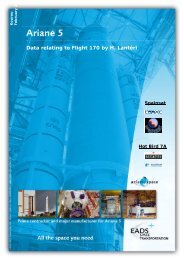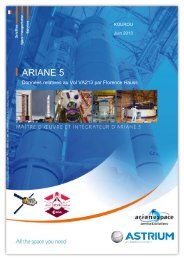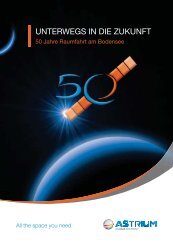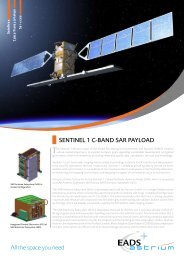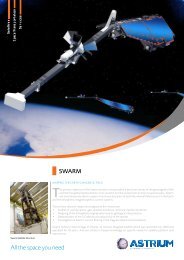Flight 207: Ariane 5 ECA/Echostar-17 - Astrium - EADS
Flight 207: Ariane 5 ECA/Echostar-17 - Astrium - EADS
Flight 207: Ariane 5 ECA/Echostar-17 - Astrium - EADS
You also want an ePaper? Increase the reach of your titles
YUMPU automatically turns print PDFs into web optimized ePapers that Google loves.
Data relating to <strong>Flight</strong> <strong>207</strong><br />
MSG-3<br />
The Meteosat Second Generation (MSG) system<br />
is responsible for observation of the atmosphere<br />
from geostationary orbit at longitude 0°. As part of<br />
the global operational satellite-based meteorology<br />
system, MSG follows on from the first generation of<br />
satellites and the original Meteosat Operational<br />
Program (MOP) system. The MSG programme is a<br />
complete system, comprising a ground segment and<br />
four satellites. The European Space Agency (ESA)<br />
runs the MSG programme on behalf of Eumetsat,<br />
the European satellite-based meteorology organisation,<br />
which today comprises 26 member states and 5<br />
cooperating states.<br />
The space segment consists of two MSG satellites,<br />
in orbit simultaneously to guarantee the high level of<br />
availability required for the mission, with one satellite<br />
operational and the other on standby. MSG-1 (MET-<br />
8) was launched in August 2002 and MSG-2 (MET-<br />
9) in December 2005. The launch of MSG-4 is<br />
planned for 2015. All the MSG satellites are built by<br />
a European consortium headed by Thales Alenia<br />
Space.<br />
The MSG satellites work in conjunction with the low-Earth orbit weather satellites, such as the<br />
European METOP. The advantage of geostationary satellite data is that they are global and<br />
permanent. They are thus the basis for the work of the forecasters, who then refine the information<br />
using that provided by the low-orbit satellites, which scan the surface of the globe with<br />
extremely high precision.<br />
The Météosat Programme is part of the<br />
World Weather Watch.<br />
21




